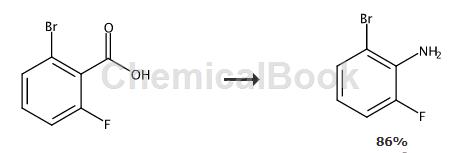Overview[1][2]
2-Bromo-6-fluoroaniline is an aniline compound and can be used as an intermediate for pharmaceutical and chemical synthesis. If 2-bromo-6-fluoroaniline is inhaled, move the patient to fresh air; if there is skin contact, take off contaminated clothing, rinse the skin thoroughly with soap and water, and seek medical attention if you feel uncomfortable; if the eyes are clear, In case of contact, separate eyelids, rinse with running water or saline, and seek medical attention immediately; if ingested, rinse mouth immediately, do not induce vomiting, and seek medical attention immediately. Advice to protect rescuers is as follows: Move the patient to a safe place, consult a doctor, and if conditions permit, please show this chemical safety data sheet to the doctor who comes to the scene. If there is a small leak, collect the leaked liquid in a sealable container as much as possible, absorb it with sand, activated carbon or other inert materials, and transfer it to a safe place. Do not flush it into the sewer; if there is a large leak, build a dike or dig a pit. Contain, seal the drainage pipe, cover it with foam to inhibit evaporation, use an explosion-proof pump to transfer it to a tanker or a special collector, and recycle or transport it to a waste treatment site for disposal.
Preparation [1-2]
The preparation of 2,6-difluoroaniline is as follows:

Dissolve 2,6-difluorobenzoic acid (1.0 equivalent) in concentrated sulfuric acid (H2SO4, 2.5mL/mmol dihalobenzoic acid), heat to 60°C, and keep for 1.5 hours. The solution was then cooled to room temperature and sodium azide (NaN3) was added. The resulting mixture was stirred at room temperature for 42 hours, then cooled to 0°C and basified with concentrated ammonium hydroxide (NH4OH).
Extract the organic matter with ethyl acetate (EtOAc, 3×10-20mL). The organic layers were combined, washed with saturated sodium chloride (NaCl, 1×10-20mL), dried over magnesium sulfate (MgSO 4), and concentrated under reduced pressure to obtain crude product 2,6-difluoroaniline. 1H NMR [400MHz, (CD3)2CO] δ7.22 (dd, J = 1.0,8.2,1H), 7.00 (ddd, J = 0.9,1.0,8.2Hz 1H), 6.57 (td, J = 5.5,8.2, 1H), 4.86 (s, 2H) 13C NMR [400MHz, (CD3)2CO] δ 164.08, 159.08 (d, J = 1000Hz), 132.18 (d, J = 35Hz), 128.75 (d, J = 14 Hz), 125.46 (d, J = 84Hz), 119.14 (d, J = 19Hz), 114.96 (d, J = 85Hz).
Main reference materials
[1] Synthesis of Pyrrolnitrin and Related Halogenated Phenylpyrroles

 微信扫一扫打赏
微信扫一扫打赏

